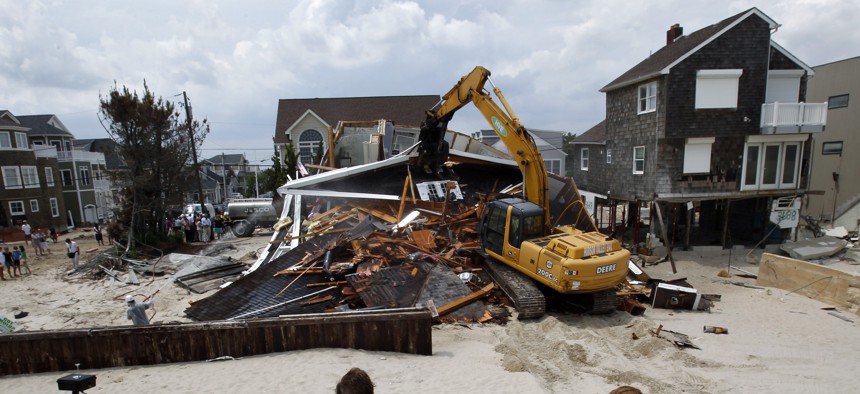Lessons on Rebuilding Low-Cost Rental Units After A Disaster

People watch from the beach Wednesday, July 10, 2013, as a home severely damaged by Superstorm Sandy is demolished in the Normandy Beach section of Toms River, N.J. AP Photo/Mel Evans
The National Low Income Housing Coalition examined the loss of low-cost rental housing in New Jersey after Hurricane Sandy, recommending steps that can be taken by other communities to preserve or rebuild.
Hurricane Sandy caused an estimated $70.2 billion in damage, hitting low-income residents particularly hard. About 43% of the 500,000-plus households in New York and New Jersey that asked for federal aid after the 2012 storm reported annual incomes of under $30,000.
A new report examines the loss of low-cost housing in some of the communities hardest hit by the storm, finding that federal aid programs aimed at rebuilding affordable housing stock were often underutilized and were unable to prevent the loss of low-cost rental housing.
The report, released this month by the National Low Income Housing Coalition, could have implications for communities far beyond the Jersey shore. At least 10 natural disasters, including hurricanes and storm flooding, generated at least $1 billion in losses in the United States in 2019, according to the National Oceanic and Atmospheric Administration.
Across all of New Jersey, the hurricane damaged more than 16,500 rental homes. The coalition assessed the loss and recovery of rental housing in Atlantic, Monmouth, and Ocean counties. It found that while Atlantic County saw a 1% increase in low-cost rental units between 2011 and 2017, adding 173 units, Monmouth and Ocean counties each lost low-cost housing even as property owners rebuilt. The number of units rented for under $750 a month decreased by 14% in Monmouth County and 8% in Ocean County, despite the addition of more than 4,000 rental housing units in each county over the same period.
“While government intervention brought necessary resources to aid the recovery of the rental housing stock, it proved unable to prevent the loss of low-cost rental housing in some communities,” the report found.
The low-cost coastal units lost due to Hurricane Sandy were among the more than 29,000 low-cost rental units the state lost between 2011 and 2017.
The report cites a number of factors for the losses. Housing markets in New Jersey’s coastal region were already heating up before the 2012 storm, with real estate investors seeking investment opportunities there. The report said the damage caused by the storm created “significant opportunities for investors to buy properties during the recovery.”
“Many property owners struggled to afford the cost of recovery, with some either choosing or being forced to sell their properties,” the report found. “The characteristics of the rental stock in many coastal communities also meant that owners were often small-scale landlords of older housing who may not have had adequate reserves or access to capital, depending on the cashflow from their properties.”
Renters did get some immediate assistance, but the coalition found that longer-term rebuilding help wasn’t as successful.
The Federal Emergency Management Administration paid for 3,500 renters to stay in hotels across the state for several months after the hurricane. Meanwhile, FEMA’s individual aid program doled out nearly $104 million in assistance to 21,000 renters, including $66 million in rental assistance for temporary housing.
Long-term programs did not offer enough assistance or were difficult for small property owners to navigate, the report found. Projects funded through a program that was designed to provide zero- or low-interest loans to build or rehabilitate affordable multifamily housing took years to materialize. As a result, the programs “were not available to immediately meet the housing needs of displaced residents,” the report states.
“The lowest-income renters face a significant shortage of affordable rental homes even in the best of times. This shortage is further exacerbated by disasters. At the same time, federal recovery funds tend to disproportionately benefit homeowners over renters,” said Diane Yentel, the president and CEO of the housing coalition. “To prevent the displacement of extremely low-income renters, we must make policy changes to ensure renters, especially those with the lowest incomes, are not forgotten and are treated equitably before and after disasters strike.”
To be better prepared to meet the needs of low-income residents and to preserve affordable rental housing in the wake of a disaster, the housing coalition made several suggestions. Among the recommendations:
- New Jersey lacked sufficient data that would allow it to identify small income properties. The report suggests states should invest in rent registries that could give recovery planners more information on the amount of housing stock lost or damaged.
- Very few affordable rental projects were completed two years after Hurricane Sandy. The report recommends that states and the federal government develop rental assistance programs that could provide help for renters for longer than two years.
- The shortage of low-cost housing is exacerbated after a natural disaster. The report suggests that deeper subsidies should be provided for low-income renters to assist them in finding both temporary and long-term housing in the wake of a disaster.
Andrea Noble is a staff correspondent with Route Fifty.
NEXT STORY: South Carolina Lawmaker Wants to Mandate Media Literacy Classes





